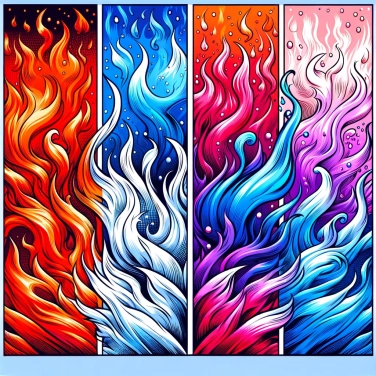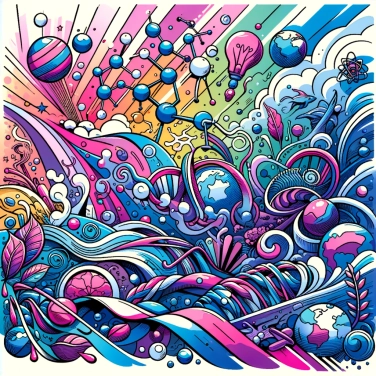The fire is red at low temperatures (around 1000°C) due to the emission of light by soot particles. When it reaches higher temperatures (around 1200-1400°C), it becomes orange, then blue at even higher temperatures (above 1400°C) due to changes in the chemical components emitting light.

The color of fire primarily depends on its temperature. The higher it is, the more the flame turns blue. A rather "cool" fire (around 800°C to 1000°C) appears dark red to bright red. When the temperature rises to about 1100°C to 1300°C, the flame becomes orange, somewhat like that of a classic fireplace. Around 1400°C to 1600°C, the fire shifts to yellow and becomes much brighter. From 1700°C, the flame takes on a brilliant white hue, and when it exceeds this temperature significantly (around 2000°C and above), it even turns blue, indicating that it is reaching a truly high energy level. As the temperature increases, the emitted light energy becomes greater, with light transitioning from warm colors (red, orange) to higher-energy colors (blue and even violet exceptionally).
A fire emits light because its heated particles emit electromagnetic radiation, this is called thermal emission. The hotter a flame is, the more it emits high-energy, short-wavelength light waves. At lower temperatures, the light mainly remains in the infrared range, and thus is not visible to our eyes. As it heats further, the light enters the visible spectrum, and then clearly becomes blue at very high temperatures. In short, temperature determines color: red or orange flames are rather cool (below about 1200°C) and emit more low-energy waves, while blue flames easily reach 1400°C or more, producing high-energy light. The famous electromagnetic spectrum clearly explains why a fire can change from red to blue simply by becoming hotter.
The color of a flame is not only a matter of temperature; chemical elements also play a key role. When you burn different materials, the elements present in them release a specific color. For example, sodium gives that typical orange flame seen in street lighting; you may notice that your toaster or gas stove can sometimes produce an orange flame because sodium is present. Copper, on the other hand, tends to produce a bright blue-green, like those pretty flames you get when burning certain metallic salts in chemistry. Potassium produces a soft purple color, while calcium generates a reddish-orange hue. These are the famous "flame tests" commonly used to quickly identify certain chemical elements. So, alongside temperature, chemical elements are also responsible for the beautiful palette of colors you can observe during your campfires or fireworks displays.
When you light a candle, the flame is often a yellow-orange color because it burns at a fairly modest temperature. The gas from your lighter, on the other hand, produces a rather blue flame: normal, as it easily reaches the higher temperatures necessary for that color. Have you ever noticed that matches initially produce a red-orange flame? The temperature is low, and the glowing carbon particles give that reddish effect. In contrast, the home gas stove almost always displays a clear blue flame, a sign of efficient and complete combustion at high temperatures. As for the wood fire in your fireplace, the bright red embers are a sign of moderate heat that is higher than yellow flames because they heat more than they burn.
The meticulous observation of flame colors allows firefighters and metallurgists to roughly estimate the temperature of a fire or a furnace without complex instrumentation.
The black smoke released by certain yellow or orange flames indicates incomplete combustion due to a lack of oxygen, while a blue flame often signifies an efficient, complete, and clean reaction.
Astronauts aboard the ISS have observed that flames, in the absence of Earth's gravity, become spherical, bluish, and burn slowly, as the convection of hot air is absent in space.
The greenish color seen in certain flames generally comes from the presence of copper-based compounds, which are frequently used in fireworks as colorants.
This often occurs when various substances are burning simultaneously or when combustion is incomplete in certain areas. The varying combustion temperature, as well as the presence of different molecules or particles, locally influences the color of the flame.
The black fire, as we imagine it (a flame producing black light), does not physically exist in the strict sense. However, the term "black fire" is sometimes used in poetic or figurative contexts to refer to a combustion that produces very little visible light or is almost invisible to our eyes, such as a slow combustion or one with very low luminous energy.
Gas burners produce a more complete combustion, with a higher temperature and fewer glowing particles, resulting in a blue flame. In contrast, wood or candles generally produce a less complete combustion with more glowing solid particles, giving the flame its red-orange color.
Sure! Here’s the translation: "Yes, the unusual color of a flame (green, purple, or pink, for example) typically comes from the presence of specific chemical elements that are intentionally added. For instance, copper creates a green flame, while potassium produces a purple flame."
As the temperature of a flame increases, its light emission shifts towards shorter wavelengths (pale blue or white). This can be explained by the physics of thermal radiation: the higher the temperature, the greater the energy of the emitted photons, which corresponds to hues closer to white or blue on the visible spectrum.
A red-orange flame generally corresponds to temperatures around 700-1000°C, a yellow-white flame to about 1200-1500°C, and a blue flame indicates temperatures above 1500°C, reaching 3000°C or more.

0% of respondents passed this quiz completely!
Question 1/6